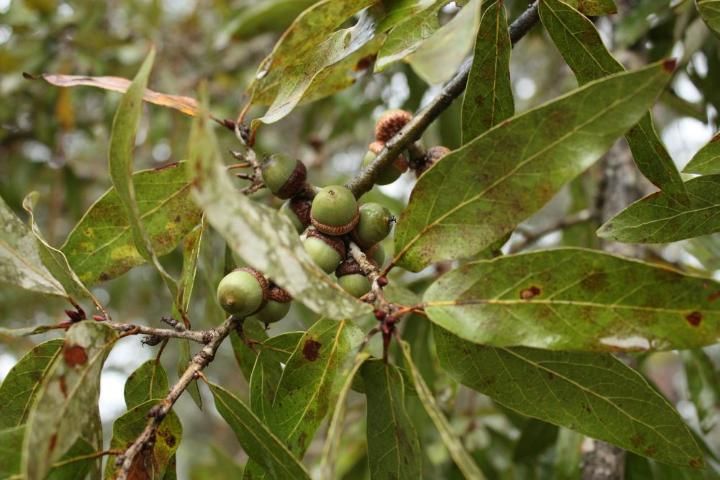Family
Fagaceae, beech and oak family.
Genus
Quercus is the Latin word for "oak," and it is formed from two Celtic words: quer meaning "beautiful" and cuez meaning "tree."
Species
The species name incana stems from the Latin word incan, which means "gray or white with age."
Common Names
Bluejack Oak, Scrub Oak
The name "bluejack" refers to the bluish color of the leaves. The name "scrub oak" stems from the habitat where this species grows. However, at least six other oak species (Q. chapmanii, Q. geminata, Q. laevis, Q. margarettae, Q. myrtifolia, and Q. pumila) go by the name "scrub oak," so it is best to use the scientific name when referring to this tree.
Description
This deciduous and native shrub-like tree frequents the xeric sandy soils of ridges, sandhills, and scrub from Virginia south to Florida and west to Texas and Oklahoma. It grows best in full sun and can reach heights of up to 55 feet. Leaves are simple and alternate, and grow between 1 to 4 inches long. The leaves are narrowly elliptic to lanceolate in shape. Leaf margins or edges are smooth and the tip of the leaf is pointed. The top side of the leaf is bluish to ashy green, and the underside is silvery with a light layer of pubescence or hair. The thick bark is dark gray to black and has wide and deep furrows or grooves. Acorns mature in two years, yielding nuts that are small (ranging from 3/8 to 5/8 inches long) and brown. The top 1/4 of the nut is attached to a reddish-brown cup that exhibits pubescence on its underside.

Credit: CA Floristics, CC BY-NC-ND 2.0
Allergen
All members of this genus are known to produce large amounts of pollen, making both deciduous and evergreen oaks highly to extremely allergenic.
Applications
Horticultural
As with most oaks, bluejack oak has a superior ability to attract wildlife. For this reason, gardeners who are interested in providing a haven for wildlife in the midst of urbanization often plant oaks. However, as subdivision yard sizes have shrunk over time, the planting of a larger tree, such as a live oak (Quercus virginiana), is often impractical. Smaller oaks such as the bluejack oak can be used instead. While bluejack oak can reach heights of 55 feet, it generally is a small-statured tree and can be "trained" as such. Additionally, this species does not sprout from underground runners and, therefore, will not take over a garden as do many other oaks. Because scrub is the natural habitat of bluejack oak, it is adapted to droughty environments, making it a water-conserving species that is easy to care for. Like other oaks, the leaves and acorns have high tannin content that will stain light colored concrete, so it's best to plant this tree away from susceptible areas if such an occurrence is undesirable.
Wildlife
The acorns of the bluejack oak attract many types of wildlife, including various species of birds and mammals, such as squirrels, raccoons, wild turkey, and deer.
References
Austin, D. F. 2004. Florida ethnobotany. Boca Raton, FL: CRC Press.
Borror, D. J. 1988. Dictionary of root words and combining forms (1st ed.). Mountain View, CA: Mayfield Publishing Company.
Dictionary.com. (2010). bluejack, Retrieved from http://dictionary.reference.com/browse/bluejack
Gledhill, D. 1989. The names of plants (2nd ed.). Cambridge: Press Syndicate of the University of Cambridge.
Godfrey, R. K. 1988. Trees, shrubs, and woody vines of Northern Florida and adjacent Georgia and Alabama. Athens, GA: The University of Georgia Press.
Kurz, H. and R. K. Godfrey. 1993. Trees of Northern Florida. Gainesville, FL: University Press of Florida.
Nelson, G. 1994. The trees of Florida: A reference and field guide. Sarasota, FL: Pineapple Press.
Ogren, T. L. 2000. Allergy-free gardening: The revolutionary guide to healthy landscaping. Berkeley, CA: Ten Speed Press.
Osorio, R. 2001. A gardener's guide to Florida's native plants. Gainesville, FL: University Press of Florida.
Stein, J., D. Binion, and R. Acciavatti. 2003. Field guide to native oak species of Eastern North America. Morgantown, WV: USDA Forest Service.